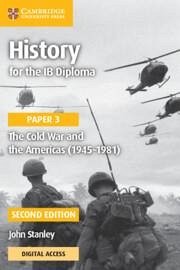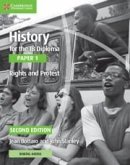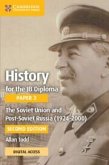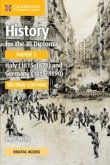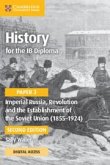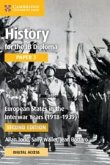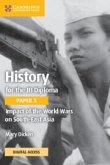John Stanley
History for the IB Diploma Paper 3 the Cold War and the Americas (1945-1981) with Digital Access (2 Years)
John Stanley
History for the IB Diploma Paper 3 the Cold War and the Americas (1945-1981) with Digital Access (2 Years)
- Broschiertes Buch
- Merkliste
- Auf die Merkliste
- Bewerten Bewerten
- Teilen
- Produkt teilen
- Produkterinnerung
- Produkterinnerung
Comprehensive books to support study of History for the IB Diploma Paper 3, revised for first assessment in 2017.
Andere Kunden interessierten sich auch für
![History for the IB Diploma Paper 2 with Digital Access (2 Years) History for the IB Diploma Paper 2 with Digital Access (2 Years)]() Allan ToddHistory for the IB Diploma Paper 2 with Digital Access (2 Years)57,99 €
Allan ToddHistory for the IB Diploma Paper 2 with Digital Access (2 Years)57,99 €![History for the IB Diploma Paper 1 Rights and Protest Rights and Protest with Digital Access (2 Years) History for the IB Diploma Paper 1 Rights and Protest Rights and Protest with Digital Access (2 Years)]() Jean BottaroHistory for the IB Diploma Paper 1 Rights and Protest Rights and Protest with Digital Access (2 Years)47,99 €
Jean BottaroHistory for the IB Diploma Paper 1 Rights and Protest Rights and Protest with Digital Access (2 Years)47,99 €![History for the IB Diploma Paper 3 The Soviet Union and post-Soviet Russia (1924-2000) Coursebook with Digital Access (2 Years) History for the IB Diploma Paper 3 The Soviet Union and post-Soviet Russia (1924-2000) Coursebook with Digital Access (2 Years)]() Allan ToddHistory for the IB Diploma Paper 3 The Soviet Union and post-Soviet Russia (1924-2000) Coursebook with Digital Access (2 Years)41,99 €
Allan ToddHistory for the IB Diploma Paper 3 The Soviet Union and post-Soviet Russia (1924-2000) Coursebook with Digital Access (2 Years)41,99 €![History for the IB Diploma Paper 3 Italy (1815-1871) and Germany (1815-1890) Coursebook with Digital Access (2 Years) History for the IB Diploma Paper 3 Italy (1815-1871) and Germany (1815-1890) Coursebook with Digital Access (2 Years)]() Mike WellsHistory for the IB Diploma Paper 3 Italy (1815-1871) and Germany (1815-1890) Coursebook with Digital Access (2 Years)31,99 €
Mike WellsHistory for the IB Diploma Paper 3 Italy (1815-1871) and Germany (1815-1890) Coursebook with Digital Access (2 Years)31,99 €![History for the IB Diploma Paper 3 Imperial Russia, Revolution and the Establishment of the Soviet Union (1855-1924) Coursebook with Digital Access (2 Years) History for the IB Diploma Paper 3 Imperial Russia, Revolution and the Establishment of the Soviet Union (1855-1924) Coursebook with Digital Access (2 Years)]() Sally WallerHistory for the IB Diploma Paper 3 Imperial Russia, Revolution and the Establishment of the Soviet Union (1855-1924) Coursebook with Digital Access (2 Years)30,99 €
Sally WallerHistory for the IB Diploma Paper 3 Imperial Russia, Revolution and the Establishment of the Soviet Union (1855-1924) Coursebook with Digital Access (2 Years)30,99 €![History for the IB Diploma Paper 3 European States in the Interwar Years (1918-1939) Coursebook with Digital Access (2 Years) History for the IB Diploma Paper 3 European States in the Interwar Years (1918-1939) Coursebook with Digital Access (2 Years)]() Allan ToddHistory for the IB Diploma Paper 3 European States in the Interwar Years (1918-1939) Coursebook with Digital Access (2 Years)24,99 €
Allan ToddHistory for the IB Diploma Paper 3 European States in the Interwar Years (1918-1939) Coursebook with Digital Access (2 Years)24,99 €![History for the IB Diploma Paper 3 Impact of the World Wars on South-East Asia Coursebook with Digital Access (2 Years) History for the IB Diploma Paper 3 Impact of the World Wars on South-East Asia Coursebook with Digital Access (2 Years)]() Mary DickenHistory for the IB Diploma Paper 3 Impact of the World Wars on South-East Asia Coursebook with Digital Access (2 Years)39,99 €
Mary DickenHistory for the IB Diploma Paper 3 Impact of the World Wars on South-East Asia Coursebook with Digital Access (2 Years)39,99 €-
-
-
Comprehensive books to support study of History for the IB Diploma Paper 3, revised for first assessment in 2017.
Hinweis: Dieser Artikel kann nur an eine deutsche Lieferadresse ausgeliefert werden.
Hinweis: Dieser Artikel kann nur an eine deutsche Lieferadresse ausgeliefert werden.
Produktdetails
- Produktdetails
- Verlag: Cambridge University Press
- 2nd edition
- Seitenzahl: 336
- Erscheinungstermin: 15. Mai 2019
- Englisch
- Abmessung: 226mm x 156mm x 25mm
- Gewicht: 478g
- ISBN-13: 9781108760713
- ISBN-10: 1108760716
- Artikelnr.: 56875249
- Herstellerkennzeichnung
- Libri GmbH
- Europaallee 1
- 36244 Bad Hersfeld
- gpsr@libri.de
- Verlag: Cambridge University Press
- 2nd edition
- Seitenzahl: 336
- Erscheinungstermin: 15. Mai 2019
- Englisch
- Abmessung: 226mm x 156mm x 25mm
- Gewicht: 478g
- ISBN-13: 9781108760713
- ISBN-10: 1108760716
- Artikelnr.: 56875249
- Herstellerkennzeichnung
- Libri GmbH
- Europaallee 1
- 36244 Bad Hersfeld
- gpsr@libri.de
1. Introduction; Chapter 2. The US and the Cold War 1945-61, with
case-studies of Cuba and Chile: 2.1. How are the government and political
system in the US structured?; 2.2. What were the implications for the US
and the Americas of Truman's response to the emerging Cold War from 1945 to
1950?; 2.3. What was the effect of US participation in the Korean War,
1950-53?; 2.4. How far did 'New Look' under Eisenhower and Dulles change
US-Soviet relations?; 2.5. What was the US's response to Cold War
developments in the Americas?; 2.6. Case Study: Cuba 1945-59: Why were
relations between Cuba and the US historically important?; 2.7. Case Study:
Cuba 1945-59: Why was there a revolution against Batista?; 2.8. Case Study:
Chile 1945-64: How did the early years of the Cold War affect Chile?; 2.9.
Case Study: Chile 1945-64: To what extent did the US influence Chilean
politics 1952-64?; Chapter 3. The US and the Cold War 1961-81, with
case-studies of Cuba and Chile: 3.1. How did Kennedy define US foreign
policy from 1961 to 1963?; 3.2. Why did the Vietnam War have such a
profound effect on the US and in the Americas?; 3.3. How did US foreign
policy change under Nixon in the 1970s?; 3.4. Why was Jimmy Carter an
'outsider' in foreign policy 1977-81?; 3.5. What were the implications of
US foreign policy for the Americas between 1961 and 1981?; 3.6. How did the
Cold War further influence domestic policy in the US between 1961 and
1981?; 3.7. Case Study: Cuba 1959-81: What impact did the Cuban Revolution
have on the Cold War?; 3.8. Case Study: Cuba 1959-81: Did the Cold War
influence Castro's domestic policy?; 3.9. Case Study: Chile 1964-81: How
did the left come to power in Chile?; 3.10. Case Study: Chile 1964-81: What
was the impact of the Pinochet regime after 1973?; Chapter 4. Canada and
the Cold War 1945-63: 4.1. How are the government and political system in
Canada structured?; 4.2. What were the long-term implications of the Cold
War on foreign policy in Canada between 1945 and 1963?; 4.3. To what extent
did the Cold War influence different areas of Canadian domestic policy?;
Chapter 5. Canada and the Cold War 1964-81: 5.1. What were the long-term
implications of the Cold War on foreign policy in Canada between 1964 and
1981?; 5.2. How did the Cold War in the 1960s and 1970s influence different
areas of Canadian domestic policy?; 5.3. Did the Cold War change Canada?;
Chapter 6. Exam practice; Further Reading; Index.
case-studies of Cuba and Chile: 2.1. How are the government and political
system in the US structured?; 2.2. What were the implications for the US
and the Americas of Truman's response to the emerging Cold War from 1945 to
1950?; 2.3. What was the effect of US participation in the Korean War,
1950-53?; 2.4. How far did 'New Look' under Eisenhower and Dulles change
US-Soviet relations?; 2.5. What was the US's response to Cold War
developments in the Americas?; 2.6. Case Study: Cuba 1945-59: Why were
relations between Cuba and the US historically important?; 2.7. Case Study:
Cuba 1945-59: Why was there a revolution against Batista?; 2.8. Case Study:
Chile 1945-64: How did the early years of the Cold War affect Chile?; 2.9.
Case Study: Chile 1945-64: To what extent did the US influence Chilean
politics 1952-64?; Chapter 3. The US and the Cold War 1961-81, with
case-studies of Cuba and Chile: 3.1. How did Kennedy define US foreign
policy from 1961 to 1963?; 3.2. Why did the Vietnam War have such a
profound effect on the US and in the Americas?; 3.3. How did US foreign
policy change under Nixon in the 1970s?; 3.4. Why was Jimmy Carter an
'outsider' in foreign policy 1977-81?; 3.5. What were the implications of
US foreign policy for the Americas between 1961 and 1981?; 3.6. How did the
Cold War further influence domestic policy in the US between 1961 and
1981?; 3.7. Case Study: Cuba 1959-81: What impact did the Cuban Revolution
have on the Cold War?; 3.8. Case Study: Cuba 1959-81: Did the Cold War
influence Castro's domestic policy?; 3.9. Case Study: Chile 1964-81: How
did the left come to power in Chile?; 3.10. Case Study: Chile 1964-81: What
was the impact of the Pinochet regime after 1973?; Chapter 4. Canada and
the Cold War 1945-63: 4.1. How are the government and political system in
Canada structured?; 4.2. What were the long-term implications of the Cold
War on foreign policy in Canada between 1945 and 1963?; 4.3. To what extent
did the Cold War influence different areas of Canadian domestic policy?;
Chapter 5. Canada and the Cold War 1964-81: 5.1. What were the long-term
implications of the Cold War on foreign policy in Canada between 1964 and
1981?; 5.2. How did the Cold War in the 1960s and 1970s influence different
areas of Canadian domestic policy?; 5.3. Did the Cold War change Canada?;
Chapter 6. Exam practice; Further Reading; Index.
1. Introduction; Chapter 2. The US and the Cold War 1945-61, with
case-studies of Cuba and Chile: 2.1. How are the government and political
system in the US structured?; 2.2. What were the implications for the US
and the Americas of Truman's response to the emerging Cold War from 1945 to
1950?; 2.3. What was the effect of US participation in the Korean War,
1950-53?; 2.4. How far did 'New Look' under Eisenhower and Dulles change
US-Soviet relations?; 2.5. What was the US's response to Cold War
developments in the Americas?; 2.6. Case Study: Cuba 1945-59: Why were
relations between Cuba and the US historically important?; 2.7. Case Study:
Cuba 1945-59: Why was there a revolution against Batista?; 2.8. Case Study:
Chile 1945-64: How did the early years of the Cold War affect Chile?; 2.9.
Case Study: Chile 1945-64: To what extent did the US influence Chilean
politics 1952-64?; Chapter 3. The US and the Cold War 1961-81, with
case-studies of Cuba and Chile: 3.1. How did Kennedy define US foreign
policy from 1961 to 1963?; 3.2. Why did the Vietnam War have such a
profound effect on the US and in the Americas?; 3.3. How did US foreign
policy change under Nixon in the 1970s?; 3.4. Why was Jimmy Carter an
'outsider' in foreign policy 1977-81?; 3.5. What were the implications of
US foreign policy for the Americas between 1961 and 1981?; 3.6. How did the
Cold War further influence domestic policy in the US between 1961 and
1981?; 3.7. Case Study: Cuba 1959-81: What impact did the Cuban Revolution
have on the Cold War?; 3.8. Case Study: Cuba 1959-81: Did the Cold War
influence Castro's domestic policy?; 3.9. Case Study: Chile 1964-81: How
did the left come to power in Chile?; 3.10. Case Study: Chile 1964-81: What
was the impact of the Pinochet regime after 1973?; Chapter 4. Canada and
the Cold War 1945-63: 4.1. How are the government and political system in
Canada structured?; 4.2. What were the long-term implications of the Cold
War on foreign policy in Canada between 1945 and 1963?; 4.3. To what extent
did the Cold War influence different areas of Canadian domestic policy?;
Chapter 5. Canada and the Cold War 1964-81: 5.1. What were the long-term
implications of the Cold War on foreign policy in Canada between 1964 and
1981?; 5.2. How did the Cold War in the 1960s and 1970s influence different
areas of Canadian domestic policy?; 5.3. Did the Cold War change Canada?;
Chapter 6. Exam practice; Further Reading; Index.
case-studies of Cuba and Chile: 2.1. How are the government and political
system in the US structured?; 2.2. What were the implications for the US
and the Americas of Truman's response to the emerging Cold War from 1945 to
1950?; 2.3. What was the effect of US participation in the Korean War,
1950-53?; 2.4. How far did 'New Look' under Eisenhower and Dulles change
US-Soviet relations?; 2.5. What was the US's response to Cold War
developments in the Americas?; 2.6. Case Study: Cuba 1945-59: Why were
relations between Cuba and the US historically important?; 2.7. Case Study:
Cuba 1945-59: Why was there a revolution against Batista?; 2.8. Case Study:
Chile 1945-64: How did the early years of the Cold War affect Chile?; 2.9.
Case Study: Chile 1945-64: To what extent did the US influence Chilean
politics 1952-64?; Chapter 3. The US and the Cold War 1961-81, with
case-studies of Cuba and Chile: 3.1. How did Kennedy define US foreign
policy from 1961 to 1963?; 3.2. Why did the Vietnam War have such a
profound effect on the US and in the Americas?; 3.3. How did US foreign
policy change under Nixon in the 1970s?; 3.4. Why was Jimmy Carter an
'outsider' in foreign policy 1977-81?; 3.5. What were the implications of
US foreign policy for the Americas between 1961 and 1981?; 3.6. How did the
Cold War further influence domestic policy in the US between 1961 and
1981?; 3.7. Case Study: Cuba 1959-81: What impact did the Cuban Revolution
have on the Cold War?; 3.8. Case Study: Cuba 1959-81: Did the Cold War
influence Castro's domestic policy?; 3.9. Case Study: Chile 1964-81: How
did the left come to power in Chile?; 3.10. Case Study: Chile 1964-81: What
was the impact of the Pinochet regime after 1973?; Chapter 4. Canada and
the Cold War 1945-63: 4.1. How are the government and political system in
Canada structured?; 4.2. What were the long-term implications of the Cold
War on foreign policy in Canada between 1945 and 1963?; 4.3. To what extent
did the Cold War influence different areas of Canadian domestic policy?;
Chapter 5. Canada and the Cold War 1964-81: 5.1. What were the long-term
implications of the Cold War on foreign policy in Canada between 1964 and
1981?; 5.2. How did the Cold War in the 1960s and 1970s influence different
areas of Canadian domestic policy?; 5.3. Did the Cold War change Canada?;
Chapter 6. Exam practice; Further Reading; Index.

